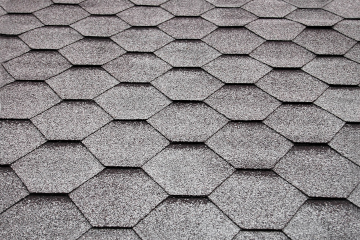Basic – Shingle Roofing

SERVICE OVERVIEW
Asphalt shingles cover more homes in America than any other roofing material. They are easy to install, provide excellent protection and are often the least expensive roofing choice.
An asphalt shingle consists of a fiberglass or organic mat coated with asphalt, then covered with colored mineral granules for protection against the elements. Asphalt shingles are available in a range of grades. The better the grade, the longer the life expectancy, which can range from 15 to 30+ years. Here’s more about the advantages of this roofing material.
Easy to install
Asphalt shingles are among the easiest roofing materials to install. The size and flexibility of shingles make it easy to adapt them to any roof size and shape.
Low-maintenance
Many roofing materials require regular maintenance to retain their appearance and performance. Asphalt shingles are easy to keep clean and can quickly be repaired or replaced if they are damaged.
Aesthetically pleasing
Asphalt shingles come in a wide selection of colors and textures. Our expert roofing contractors can help create a design that will match the architecture and décor of your home. Certain asphalt shingles can mimic the look of wood, tile or slate, giving your home an elegant finish at a lower cost.
Lightweight
Although durable, asphalt shingles are still relatively light and will not place undue stress on your home’s roofing infrastructure. Heavier materials may require additional bracing or support before installation.
Affordable
An asphalt shingle roof can be one of the lowest cost options for roofing your home, giving you an excellent return on your roofing investment.
POPULAR QUESTIONS
A: There are several clues, and the biggest one is age. If your roof is more than 20 years old, there’s a good chance it’s due for replacement. But younger roofs can fail too, so it’s a good idea to inspect a roof at least once a year. Don’t use a ladder, though. Binoculars are easier and a lot safer, and you can spot most problems from the ground.
Here’s what to look for: numerous shingles that are lifting up, cracked or missing, with curled edges, or with smooth dark areas, which indicate that the protective granules have worn off. Also, go into the attic on a sunny day and, with the lights off, check the underside of the chimney and the stack vent. If you see little pinhole spots of light, the flashing is shot—another indication that the roofing might not be in good shape.
While you’re in the attic, scan the underside of the roof sheathing for any new signs of water staining since the last inspection, as well as any soft or moist spots, which tend to show up after a heavy rain. If these problems are widespread, it’s a sure sign that you need to call a roofer.
A: First, your roofers should lay down an ice and water shield over the entire roof. Made of polyethylene and rubberized asphalt, this membrane prevents water that has slipped under shingles from penetrating to ceilings below. The valleys should then be covered with metal flashing or weaving. I would also recommend two layers of the ice and water shield on the lower section of the roof (along the eaves), around chimneys and beside the dormers.
A: Flashing is just material—usually aluminum or galvanized steel—that’s used over joints in roof and wall construction to prevent water seeping in and causing damage. Depending on the style of your house’s roof, you probably have it in the valleys, around the chimney and pipes, and around any dormer windows or skylights. Most damage shows up either in flashing that’s deteriorating due to weathering and oxidizing, or in flashing that has come loose.
I can’t say for sure without seeing your roof, but most flashing problems can be patched or repaired fairly easily. Professional roofers typically cut and shape their own flashing from sheet metal, but the most common flashing pieces also come pre-formed and can be applied without much difficulty using caulking or roof cement.
A word of warning: Because of the danger involved, I never recommend people do work on roofs unless they are professionals or they’re used to being on roofs and are familiar with the one they’re working on. So if your flashing needs any significant repairs, consider hiring a contractor to do it for you.
A: It depends on just how amateur the amateur is. The safety risks of working on a roof should be pretty obvious. I don’t personally recommend that anybody work on a roof who isn’t either a professional, or familiar with the roof from being on it on a regular basis.
The task of installing a metal roof seems pretty simple in the field, at least until you come to working at the ends and around chimneys and skylights, valleys and hips. When an amateur is putting in a metal roof there are a number of things that can go wrong and cause the roof to fail. Nail the aluminum incorrectly, for instance, and your roof will definitely leak. So if the building you’re talking about is a tool shed, that’s one thing; just be careful. If it’s your home, you’ll probably be better off letting a professional do the job.
A: There are several clues, and the biggest one is age. If your roof is more than 20 years old, there’s a good chance it’s due for replacement. But younger roofs can fail too, so it’s a good idea to inspect a roof at least once a year. Don’t use a ladder, though. Binoculars are easier and a lot safer, and you can spot most problems from the ground.
Here’s what to look for: numerous shingles that are lifting up, cracked or missing, with curled edges, or with smooth dark areas, which indicate that the protective granules have worn off. Also, go into the attic on a sunny day and, with the lights off, check the underside of the chimney and the stack vent. If you see little pinhole spots of light, the flashing is shot—another indication that the roofing might not be in good shape.
While you’re in the attic, scan the underside of the roof sheathing for any new signs of water staining since the last inspection, as well as any soft or moist spots, which tend to show up after a heavy rain. If these problems are widespread, it’s a sure sign that you need to call a roofer.
A: First, your roofers should lay down an ice and water shield over the entire roof. Made of polyethylene and rubberized asphalt, this membrane prevents water that has slipped under shingles from penetrating to ceilings below. The valleys should then be covered with metal flashing or weaving. I would also recommend two layers of the ice and water shield on the lower section of the roof (along the eaves), around chimneys and beside the dormers.
A: Flashing is just material—usually aluminum or galvanized steel—that’s used over joints in roof and wall construction to prevent water seeping in and causing damage. Depending on the style of your house’s roof, you probably have it in the valleys, around the chimney and pipes, and around any dormer windows or skylights. Most damage shows up either in flashing that’s deteriorating due to weathering and oxidizing, or in flashing that has come loose.
I can’t say for sure without seeing your roof, but most flashing problems can be patched or repaired fairly easily. Professional roofers typically cut and shape their own flashing from sheet metal, but the most common flashing pieces also come pre-formed and can be applied without much difficulty using caulking or roof cement.
A word of warning: Because of the danger involved, I never recommend people do work on roofs unless they are professionals or they’re used to being on roofs and are familiar with the one they’re working on. So if your flashing needs any significant repairs, consider hiring a contractor to do it for you.
A: It depends on just how amateur the amateur is. The safety risks of working on a roof should be pretty obvious. I don’t personally recommend that anybody work on a roof who isn’t either a professional, or familiar with the roof from being on it on a regular basis.
The task of installing a metal roof seems pretty simple in the field, at least until you come to working at the ends and around chimneys and skylights, valleys and hips. When an amateur is putting in a metal roof there are a number of things that can go wrong and cause the roof to fail. Nail the aluminum incorrectly, for instance, and your roof will definitely leak. So if the building you’re talking about is a tool shed, that’s one thing; just be careful. If it’s your home, you’ll probably be better off letting a professional do the job.
